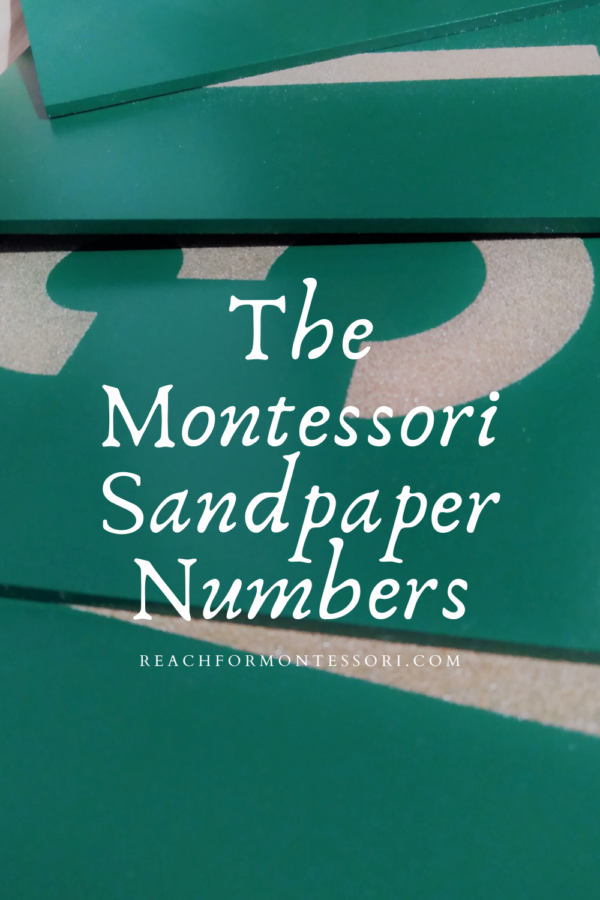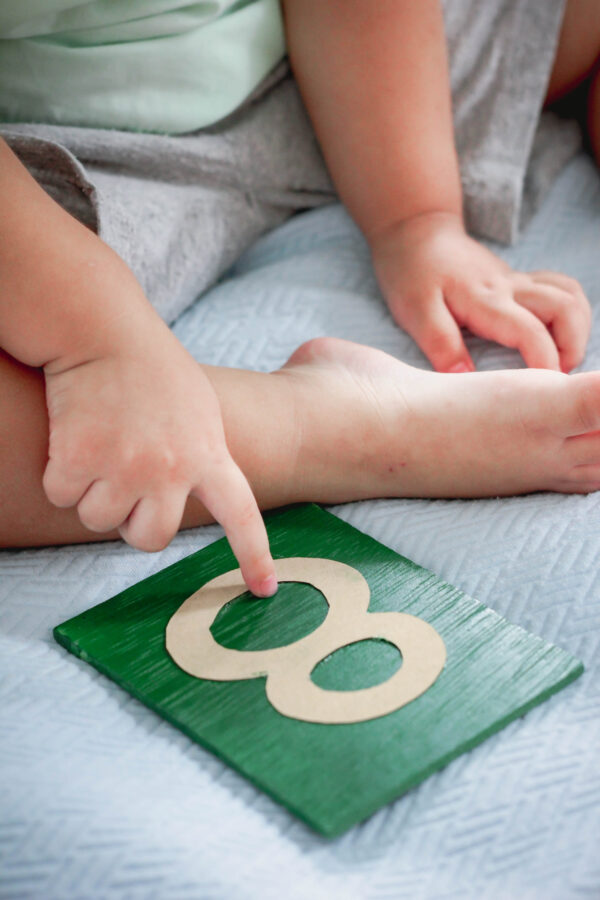Montessori math sets itself apart from traditional methods with its methodical introduction of hands-on materials. The Montessori Sandpaper Numbers are one of the first math materials a child will work with and are a great example of the Montessori method of sensorial learning.
In this article, you will learn what the Sandpaper Numbers material is, its purpose, as well as how to introduce it to your child.
You will also get ideas for activity extensions that can be done with this material.

(This post contains affiliate links. Purchasing from these links costs you nothing extra, but helps with our website upkeep.)
What are The Montessori Sandpaper Numbers?
Sandpaper Numbers in Montessori is a math material made up of 10 smooth wooden cards with the numbers 0-9 impressed in rough sandpaper.
There is sometimes a dot placed at the ends of each number to show children where to begin and end tracing, however, this is not common or necessary.
Sandpaper Numbers are used to give children a tactile impression of the written representation of quantities as they trace the numbers with their fingers.
This helps children develop muscular memory in preparation for future writing as they learn their numbers.
It also promotes a deeper understanding and connection to the written symbols they will be using to compose quantities.
The zero Sandpaper Number card is used with the one card to represent the number ten. It is also used later for activities that introduce the concept of zero, such as the Zero Game.
- 🌱Ten sandpaper numerals 0-9 mounted on green wooden board and…
- 🌱To teach the child the written symbol for numbers 1 – 10.
- 🌱Dimensions of tile: 6.5 x 5 inches; box: 6.1 x 4.6 x 3.6…
- Montessori Classic Design: Adena Montessori Sandpaper Numerals…
- Tactile Learning: Each numeral card is made with high-quality…
- Eco-friendly Materials: Made from non-toxic, eco-friendly wood…
Direct aim
- learning the numeric symbols for 1-10
- learning the names of the numeric symbols for 1-10
Indirect aim
- Preparation for writing numbers 1-10
Points of interest
- the rough sandpaper
- tracing the numbers

Montessori Sandpaper Numbers Presentation
Note: The Sandpaper Numbers are introduced to the child as a 3-period lesson.
- Invite the child to carefully carry the box of Sandpaper Numbers to the left side of the table.
- Take the 1-card from the box and put it on the table in front of the child.
- Slowly trace the number with the 2 primary fingers of you dominant hand and say, “This is one. One.”
- Repeat the previous step 2 times.
- Ask the child if they would like to trace the 1-card and name the number 3 times, the slide the card to the left of the main work space.
- Repeat these steps with the 2-card and the 3-card.
- Evaluate the child's recognition of the numbers by asking them to show you, trace, and name a random number from the 3 cards that are out.
- Complete the previous step with each of the 3 cards.
- Begin the recall phase of the lesson by pointing to each of the 3 cards at random and asking the child to trace and name each one.
- Have the child return the material to the shelf.
The Sandpaper Numbers should be introduced 3 at a time and on separate days. After the 0-9 number cards have been worked with, the 1-card and the 0-card are placed side by side to form the number 10.
Montessori Sandpaper Numbers Extensions
Number games with the Montessori Sandpaper Numbers
Using 2 sets of Sandpaper Numbers, ask the child to match them in pairs.
Sequencing
Lay out the Sandpaper Numbers randomly on a floor mat and invite the child to put them in order from 0-9.
Playing “Find a Number”
In a room with a calendar, book, magazine, or other items featuring numbers, ask the child to go around the room and point out any numbers they find.
Tracing numbers
Have the child trace numbers with the finger in a salt, cornmeal, or sand tray. The child may also enjoy tracing numbers in the air with their finger or even using their whole arm.
Building numbers
Using playdough, scraps of paper, legos, or any other material you have on hand, invite the child to form numbers.
Playing “Please Bring Me”
Order the Sandpaper Numbers on a large work mat on the floor and sit with the child across the room. Call out numbers, one at a time, at random and ask the child to bring you the correct number card.
When the child has mastered this activity, the numbers can be scattered in random order on the rug prior to the start of the game.
Sandpaper Numbers steroegnostic game
Invite your child to close their eyes or apply a blindfold if desired, and hand them a number card. Let them feel the number and try to guess which number card they are holding.
Sandpaper Numbers are such a simple item, however, they are effective in helping children understand numbers, and they are used in so many ways in early Montessori math.
Have you introduced Sandpaper Numbers in your home? If so, have you come up with any creative activity extensions or games you would like to share?
Cheers and don't forget to subscribe!


